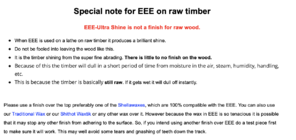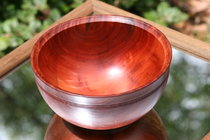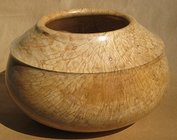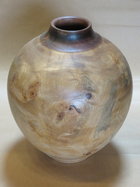Have never use a polishing wax like Yorkshire Grit or EEE. The main reason is I was concerned about using it and then trying to apply a finish of just about anything. I have seen recipes using mineral oil, bees wax and Diatomaceous earth. Bees wax and mineral oil are my concerns. So is there a method or something where the finish isn’t affected? I am assuming it is used before any finish is applied.
-
April 2025 Turning Challenge: Turn an Egg! (click here for details) -
Congratulations to Kelly Shaw winner of the March 2025 Turning Challenge (click here for details) -
Congratulations to Ellen Starr for "Lotus Temple" being selected as Turning of the Week for 21 April, 2025 (click here for details) -
Welcome new registering member. Your username must be your real First and Last name (for example: John Doe). "Screen names" and "handles" are not allowed and your registration will be deleted if you don't use your real name. Also, do not use all caps nor all lower case.
You are using an out of date browser. It may not display this or other websites correctly.
You should upgrade or use an alternative browser.
You should upgrade or use an alternative browser.
I should know this, but don’t - Polishing Paste Yorkshire Grit, EEE
- Thread starter William Rogers
- Start date
Have never use a polishing wax like Yorkshire Grit or EEE. The main reason is I was concerned about using it and then trying to apply a finish of just about anything. I have seen recipes using mineral oil, bees wax and Diatomaceous earth. Bees wax and mineral oil are my concerns. So is there a method or something where the finish isn’t affected? I am assuming it is used before any finish is applied.
I use my own brew of bees and carnauba wax, turpentine and diatomaceous earth on 98% of everything I turn. Have done so for many decades. It's very quick to apply as a friction polish but not water resistant, however, will polish up again with a light application and buff with mineral oil, which is what I use on the other 2% of my work that I expect will come into contact with moisture.
I use it to polish up the finish or as a final action on an oil finish.
I've known turners who've used wax (from a can) while sanding, then used lacquer as a finish with seemingly no problems. I share your concerns about adhesion issues so I don't.
I've worked hard to figure out how to get the best surface off the tool so sanding is more of a refining an already good surface than fixing something left behind.
Yorkshire Grit says use, then apply finish of choice, without distinction. U-Beaut EEE says, " if you intend using another finish over EEE do a test piece first to make sure it will work. This may well avoid some tears and gnashing of teeth down the track.".
Haven't used Y/G but have used EEE to "finish the finish" (lacquer) to a hi-gloss. It certainly works, but I've gravitated to automotive polishing compounds mostly because they work and I'm cheap...
The main takeaway from all the reading and research is... do a test piece first... The worst part is, I've already learned that lesson, but I'm sure I will have to learn it again, and, I'm sure I will shed a tear, gnash my teeth and probably even rend my garment...
I've worked hard to figure out how to get the best surface off the tool so sanding is more of a refining an already good surface than fixing something left behind.
Yorkshire Grit says use, then apply finish of choice, without distinction. U-Beaut EEE says, " if you intend using another finish over EEE do a test piece first to make sure it will work. This may well avoid some tears and gnashing of teeth down the track.".
Haven't used Y/G but have used EEE to "finish the finish" (lacquer) to a hi-gloss. It certainly works, but I've gravitated to automotive polishing compounds mostly because they work and I'm cheap...
The main takeaway from all the reading and research is... do a test piece first... The worst part is, I've already learned that lesson, but I'm sure I will have to learn it again, and, I'm sure I will shed a tear, gnash my teeth and probably even rend my garment...
I use either or under watco danish oil, don't know if you are supposed to or not and have been doing it for a while but I don't know about long term effect.
The triple e says something on the tub about being a surface prep for whatever finish. I took that to heart but I do use a clean paper towel after polishing on the lathe and give it a good buff just to make sure I have as much as I can removed.
The triple e says something on the tub about being a surface prep for whatever finish. I took that to heart but I do use a clean paper towel after polishing on the lathe and give it a good buff just to make sure I have as much as I can removed.
I have found that using Yorkshire Grit followed by Hampshire Sheen or Ack's Abrasive Sanding Paste followed by Ack's Polishing Paste gives a very nice finish that so far has been very long lasting when applied correctly.
If I am understanding better, these products are meant to be the finish or used over a finish. And a finish likely should not be applied over them.
Does this sound right?
Does this sound right?
Neil, what is the purpose of adding turpentine to the brew. And if you care to share what is your mix ratio of the ingredients?I use my own brew of bees and carnauba wax, turpentine and diatomaceous earth on 98% of everything I turn. Have done so for many decades. It's very quick to apply as a friction polish but not water resistant, however, will polish up again with a light application and buff with mineral oil, which is what I use on the other 2% of my work that I expect will come into contact with moisture.
This is how I do it. If there is exceptional chatoyance in the wood, I will sometime use a tung oil first followed by the Ack's Sanding/ Polishing schedule.I have found that using Yorkshire Grit followed by Hampshire Sheen or Ack's Abrasive Sanding Paste followed by Ack's Polishing Paste gives a very nice finish that so far has been very long lasting when applied correctly.
Last edited:
Anecdotally, it seems like anything goes. I would think waxes or oils could be applied over the waxes and oils of Y/G or EEE with no issues. I would be cautious using a film finish, i.e., lacquer, varnish or polyurethane, but only because I don't know the chemistry and whether or not there would be an adhesion issue.
As we have found, there is usually not a "one size fits all". I remember this from years past.
"Adhesion Problems and Degradation of Epoxy Finishes on Peg Treated Wood"
So... even with a test piece it might take years to get the results...
From Yorkshire Grit

From U Beaut

As we have found, there is usually not a "one size fits all". I remember this from years past.
"Adhesion Problems and Degradation of Epoxy Finishes on Peg Treated Wood"
So... even with a test piece it might take years to get the results...
From Yorkshire Grit

From U Beaut

I use yorkshire grit abrasive paste on all my hollow forms after sanding. Gives a nice look and adds color tones that I like. Much like walnut oil. I let it sit for a day or so and then apply shellac over it. I've been told that it doesn't impact the ability to put on a final finish. Shellac sticks to anything and everything it seems so I've never had any issues with it but I do make sure I get all the abrasive paste off. That said, it can also be a nice final finish with a bit of wax buffing. I've done that as well when I don't want a gloss shellac look.
Neil, what is the purpose of adding turpentine to the brew. And if you care to share what is your mix ratio of the ingredients?
The turpentine (ie gum turpentine) is the solvent that keeps the waxes soft until the turpentine evaporates off. This is particularly important for the carnauba wax, which is the ingredient that gives the finish its durable surface. Less important for the beeswax that will soften with friction during application.
I have found that one of the functions of the rotten stone/yorkshire grit in the polish is to cut back any build up during application, which is most needed on pieces that have larger surface areas.
My brew has evolved over many years to being something now like half of this pot to two tips of that and three smidgens of this other one, so not readily conveyed in standard measurable amounts. I will try to see if I can find what I might have written down somewhere that might be more useful and try to work out how close it is to what I'm currently using.
I have used both products a great deal, especially Yorkshire Grit after sanding to 400 to 600-grit. They say to apply sanding sealer 1st, but I never have. I have used many finishes over it without any issue whatsoever: TruOil, Danish Oil, Walnut Oil, "shine juice," etc. I have never used it to "finish a finish," though I hear you can do that too. If I'm going to do that, I'll use the Beall buffs on a fully-cured finish.
Have you ever used a wipe on poly or anything like that over it? I don’t thing that will work.I have used both products a great deal, especially Yorkshire Grit after sanding to 400 to 600-grit. They say to apply sanding sealer 1st, but I never have. I have used many finishes over it without any issue whatsoever: TruOil, Danish Oil, Walnut Oil, "shine juice," etc. I have never used it to "finish a finish," though I hear you can do that too. If I'm going to do that, I'll use the Beall buffs on a fully-cured finish.
Thanks for the link, Clifton. It is a true cautionary tale about long-delayed finish failure by an artist widely regarded as a master craftsman. The article describes the proposed removal of the epoxy finish on one of Ed Moulthroup's large hollow forms using an unspecified solvent - that must have been a challenge.Anecdotally, it seems like anything goes. I would think waxes or oils could be applied over the waxes and oils of Y/G or EEE with no issues. I would be cautious using a film finish, i.e., lacquer, varnish or polyurethane, but only because I don't know the chemistry and whether or not there would be an adhesion issue.
As we have found, there is usually not a "one size fits all". I remember this from years past.
"Adhesion Problems and Degradation of Epoxy Finishes on Peg Treated Wood"
So... even with a test piece it might take years to get the results...
No, I haven't, but I think it would be worth testing, maybe. TruOil is about 1/3 varnish, and I have done up to a dozen or more coats over YG, and it's a beautiful finish. None of them are more than a couple years old, so long-term I can't say.Have you ever used a wipe on poly or anything like that over it? I don’t thing that will work.
When I make finials, I use a beeswax sanding lube (4 parts mineral oil & 1 part beeswax BY WEIGHT). After sanding to 400 grit, I wipe the finial down well with paper towel and then apply several coats of Deft gloss lacquer cut 50-50 with lacquer thinner. The lacquer dissolves the wax and builds a nice finish. If I don’t like the gloss level, I will spray with Deft gloss lacquer. I’ve never had any problems with the lacquer adhering to the wood.
I have made my own with mineral oil, bees wax and diatomaceous earth. I let a bowl set for 2 to 3 months and put a coat of Arm R Seal and it turned out bad.No, I haven't, but I think it would be worth testing, maybe. TruOil is about 1/3 varnish, and I have done up to a dozen or more coats over YG, and it's a beautiful finish. None of them are more than a couple years old, so long-term I can't say.
I wonder what would happen if you turned it off (your home-brew paste) with a solvent like mineral spirits and really wiped it clean and dry, then try the Arm-R Seal? With the YG I usually buff off all I can with a clean blue shop towel after the friction polishing, and then put on about anything I want. I guess we're always experimenting to see what works best. I consider myself near the beginning of my learning to finish journey.I have made my own with mineral oil, bees wax and diatomaceous earth. I let a bowl set for 2 to 3 months and put a coat of Arm R Seal and it turned out bad.
I know what you mean. Finishing is a deep dark hole on its own. I have been able to use Arm R Seal over walnut oil but you have to give it a couple of months to dry and cure first. I think the mineral oil is what ruins it for the abrasive paste.I wonder what would happen if you turned it off (your home-brew paste) with a solvent like mineral spirits and really wiped it clean and dry, then try the Arm-R Seal? With the YG I usually buff off all I can with a clean blue shop towel after the friction polishing, and then put on about anything I want. I guess we're always experimenting to see what works best. I consider myself near the beginning of my learning to finish journey.
Pretty common practice for me is a coating of walnut oil as a sanding sealer, sand to 320, a round of Acks, then oil based finish du jour....Odies, DO, T&T, and lastly Beall buff if additional sheen is required. Holds up well over time and easy to repair down the road. Howards Feed and Wax is a great choice to re-juvinate later.
Like the failure of the Moulthroup epoxy finish. We will never know the why for all finish failures so stick with old methods. I believe finish failures result from breaking the rules. I try not to apply both water and oil based products to the same piece. Failures start with surface preparation and if desired base coat. I prefer a thinned application of the finish coat as a base coat and then there is no mixture of finishes. Shellac Can be applied anytime in the process without worry.
Neil, what is the purpose of adding turpentine to the brew. And if you care to share what is your mix ratio of the ingredients?
William, I couldn't find the jars where I have written down my original ratios. If I remember correctly, I think the harder mix was 50/50 beeswax to carnauba and the softer mix was three parts beeswax to one part carnauba. I made up big batches at the time and haven't needed to do another batch for a long time.
I add sufficient pine turpentine to that to get the consistence I want. If you overdo it just leave the cap off for awhile and if not sufficiently creamy add more turpentine.
I work from smaller pots at the lathe, which I half fill to leave enough room for an application cloth that gets left in the pot so that it doesn't dry out between uses. To that half pot amount of about 5 fl ozs, or a tad over 1/2 standard cup measure, I add three tips of as much tripoli/rotten stone powder that will sit on the end of the paddle-pop stick that you can see next the jar in the following photo...
If gives a bit of sheen when its first applied, which works well while on display at the gallery, but this quietens down over time...
@Neil S Those are nice looking pieces. Well done. Thanks for looking. I ended up making some from the most common recipe, 16 oz mineral oil, 4 oz bees wax, and 4 oz D.E. for one batch. Not finding a recipe for the mix with carnauba wax, I did the same recipe, but used 2 oz bees wax and 2 oz carnauba wax. I didn’t use the turpentine. Put the wax and mineral oil in a small crock pot to melt and then poured that into a mixing bowl with the D.E. I put the mixture into my refrigerator to solidify (not sure that is necessary). It is now a paste wax consistency. I have a couple of bowls I can try. I’m going to use the non carnauba wax, followed by danish oil and the carnauba wax.
Turpentine disolves the beeswax.Neil, what is the purpose of adding turpentine to the brew. And if you care to share what is your mix ratio of the ingredients?
Turpentine or mineral spirits will dissolve or remove the wax or mineral oil used in polishing or abrasive paste. This will allow you to apply lacquer or poly for your final finish. I do like to use a sanding sealer first if i'm going to use an abrasive paste . I've had good results using homemade polishing paste after sanding to 400. Its like buffing before finishing .




